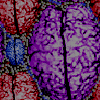



|
Summary of Basic Theory and Results for
Metaprogramming the Positive States with LSD-25 1. LSD-25 facilitates the positive (reward, positive reinforcement) systems in the CNS. 2. LSD-25 inhibits the negative (punishment, negative reinforcement) systems in the CNS. 3. LSD-25 adds noise at all levels, decreasing many thresholds in the CNS. 4. The apparent strengths of programs below the usual levels of awareness increase. 5. Programmability of metaprograms (suggestibility) increases, allowing more programming by the self-metaprogram and external sources [hypersuggestibility of H. Bernheim (1888), Clark Hull (1933).] 6. The continuous positive state (positive reinforcement, reward, pleasure) plus inhibited negative system activity causes increased positive reinforcement of the following: a. self 7. Subsequent to exposure, the effects fall off slowly over a two-to six-weeks period, during which period there is overvaluation of 6 (a-f). Residual effects can be detected up to one year. 8. Repeated exposures at weekly to biweekly periods for several months (years) maintain the above reinforcements if the above conditions, inputs and outputs can be reproduced. There is reinforcement of the positive reinforcements until the usual state before LSD-25 becomes negative. |




